The smallest animals in the world appear across various species and environments. Many of the smallest animals are visible to the eye but barely span the width of a human fingertip or palm. They live in distinct ecosystems and play a part in the ecological balance of their local regions. Size is one of their most unique features, but many are of additional scientific interest due to their distinct physical features, behavior, reproductive habits, or ecological dynamics.

The smallest animal known is Myxobolus shekel, a species of Myxozoa, which additionally ranked as the smallest invertebrate. They are microscopic parasites, with one individual measuring 0.0003 inches (8.5 µm or 0.0085 mm) in length. However, it defies classification as it demonstrates both protozoans and animal characteristics. Other examples fit a closer traditional approximation of what an animal is.
The lists below summarize these animals and their measurements, ordering them by length as weights are sometimes underreported.
- Paedophryne amauensis: The smallest vertebrate is Paedophryne amauensis, a micro frog. It measures 0.3 inches (7.7 mm) and weighs 0.0042 ounces (0.12 grams).
- Paedocypris: Paedocypris is the smallest fish and previously the smallest vertebrate before the discovery of Paedophryne amauensis. It measures 0.31 to 0.41 inches (7.9 to 10.3 mm).
- Kitti’s hog-nosed bat: Kitti’s hog-nosed bat is the world’s smallest bat and mammal tied with the Etruscan shrew. It measures 1.1 to 1.3 inches (2.8 to 3.3 cm) and weighs 0.07 ounces (2 grams). Its length is shorter than the shrew’s.
- Etruscan shrew: The Etruscan shrew is the smallest mammal besides Kitti’s hog-nosed bat. Its body mass is less than the bat, weighing 0.05 to 0.25 ounces (1.2 to 2.7 grams). However, it is longer at 1.4 to 2 inches (3.5 to 5 cm).
- Bee hummingbird: The bee hummingbird is the smallest bird in the world. They average 2 to 2.4 inches (5 to 6 cm) and weigh 0.056 to 0.071 ounces (1.6 to 2.0 grams).
- Madame Berthe’s mouse lemur: This lemur is the world’s smallest primate. The species measures 3.6 inches (9.2 cm) in length and weighs 1.1 ounces (30 grams).
- Williams’ dwarf gecko: Williams’ dwarf gecko, or the turquoise dwarf gecko, is one of the world’s smallest lizards. They measure up to 4 inches with their young being barely the width of a human fingertip.
- Speckled padloper tortoise: The speckled padloper tortoise is the smallest tortoise and thus the smallest member of the Testudine order. They measure up to 4 inches (10 cm) and weigh 5.3 ounces (150 grams).
- Slender blind snakes: These snakes make up the Leptotyphlopidae family, which includes the Barbados threadsnake. They vary in size, but average 4 to 5 inches (10 to 12 cm).
- Barbados threadsnake: The Barbados threadsnake is the smallest snake in the world. This species averages 4.1 inches (10.4 cm).
- Pygmy marmoset: The pygmy marmoset is another small primate, beat out in size by the mouse lemur. Members of this species are 4.6 to 6.2 inches (11.7 to 15.8 cm) in length and weigh 3.5 to 4.9 ounces (100 to 140 grams).
- Dwarf lanternshark: The dwarf lanternshark is the smallest species of shark. They can grow up to 8.3 inches (21 cm).
- Pygmy rabbit: Pygmy rabbits are the smallest members of the Leporidae (rabbits and hare) family. They’re often 9.4 to 11.6 inches (24 to 29.5 cm) in length and weigh 14 ounces (400 grams).
The animals listed above live in diverse ecosystems. Some are flying species, such as Kitti’s hog-nosed bat and bee hummingbird, while others live in leaf litter like Paedophryne amauensis and slender blind snakes. They impact their environments by acting as prey for other, larger animals or by preying on other microorganisms. Due to their size, the animals stand out amongst their taxonomic order or family. However, many are listed as endangered or threatened due to the impact of human activity and dangers such as the pet trade, and thus are protected by regional, national, or international law.
1. Paedophryne amauensis
Paedophryne amauensis is the world’s smallest frog and vertebrate. It features an average body weight of 0.0042 ounces (0.12 grams) and a record length of 0.3 inches (7.7 mm). This means that the frog is less than half the size of a US dime. Its position as the world’s smallest vertebrate is contested by the fish species, Paedocypris, which ranges from 0.31 to 0.41 inches. Other physical features include granular skin, unwebbed fingers, brown-black camouflage, and the ability to jump thirty times its body length. It’s distinct among its genus for its short snout-vent length (the distance from its nose tip to cloaca) and comparatively long legs.
View in gallery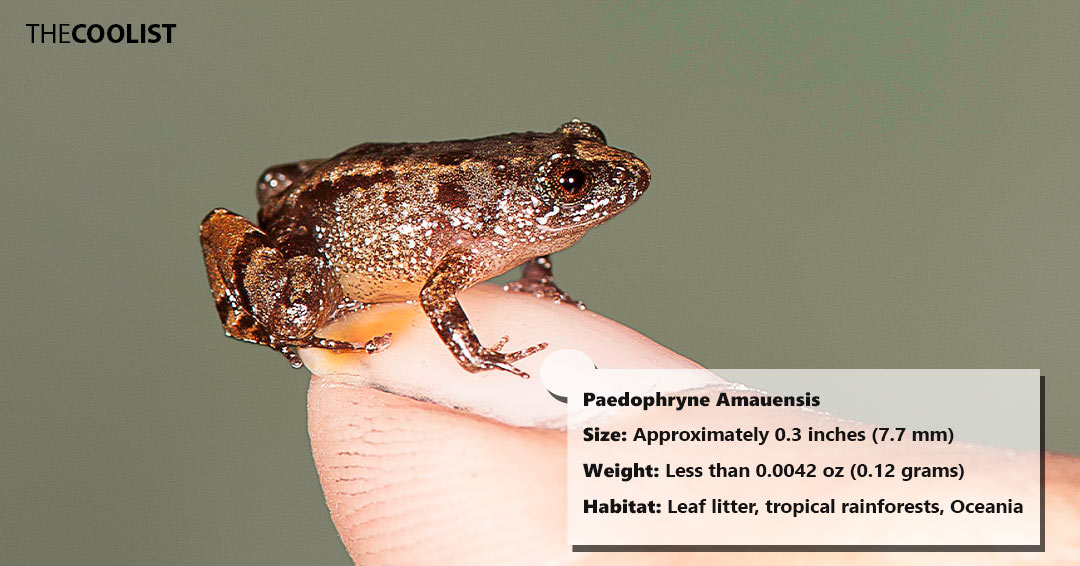
Paedophryne amauensis’ habitat resides in eastern Papua New Guinea’s tropical wet lowlands and hill forests. It is not aquatic unlike many other amphibians, and lives in leaf litter. Consequently, it lacks a tadpole stage and demonstrates direct development during its reproduction cycle. This means that offspring (called “froglets”) emerge from eggs as fully formed albeit tiny amphibians. The frog is insectivorous, which means it preys on tiny invertebrates. It doesn’t have any known predators but likely uses its size, colorization, and habitat to escape predation from larger vertebrates or invertebrates. Additionally, the Paedophryne amauensis is nocturnal and navigates the forest floor at night.
The ecological role of Paedophryne amauensis centers on its diet. It contributes to the control of insect populations, serving as a type of predator in its habitat. Human interaction with this species is minimal and primarily centers on scientific research due to its unique size. Its conservation status is of least concern, though potential threats lie in the increasing deforestation and other human activities in Papua New Guinea.
2. Paedocypris
Paedocypris is a genus that holds the record of the world’s smallest fish. Members of the genus such as Paedocypris progenetica measure as large as 0.41 inches (10.3 mm) and as small as 0.31 inches (7.9 mm). The fish features a translucent body that barely spans the width of a human fingertip. Their average weight is underreported but likely weigh well below an ounce. The genus contests Paedophryne amauensis as the world’s smallest vertebrate. However, the micro frogs average 0.3 inches in length whereas this species of fish can grow to exceed this length by a fraction. Therefore, Paedophryne amauensis is generally regarded as the smallest documented vertebrate.
View in gallery
The Paedocypris genus is native to the peat swamp forests of Southeast Asia. They’re found in Sumatra and Bintan, Indonesia, and northern Borneo, Malaysia where they dwell in acidic, low-oxygen waters. Paedocypris isn’t classified as an extremophile, but it is common for micro-species to live in extreme environments where larger organisms cannot. They feed on microscopic organisms, which likely makes them crucial in the ecological balance of their habitats. Additionally, the fish demonstrate burrowing behaviors to survive droughts.
Ecologically, Paedocypris are part of their habitats’ food web much like other small animals. They prey on other microorganisms but likely serve as food for larger fish or invertebrates. Human interaction is minimal. The fish species are primarily of scientific interest due to their size but offer no commercial value as food or as pets. Consequently, Paedocypris or species such as Paedocypris progenetica are not endangered. However, they rank as threatened as they’re vulnerable to habitat loss because of their distinct, limited environments.
3. Kitti’s hog-nosed bat
Kitti’s hog-nosed bat (Craseonycteris thonglongyai or the bumblebee bat) is the world’s smallest bat. It additionally ranks as the world’s smallest mammal, tied with the Etruscan shrew. This species of bat averages a length of 1.1 to 1.3 inches (2.8 to 3.3 cm) and a weight of 0.07 ounces (2 grams). It’s consequently shorter than the Etruscan shrew but heavier. Other physical features include its distinctive pig-like snout, compact wing width, and lack of a noticeable tail.
View in gallery
The limestone caves of Thailand and Myanmar comprise Kitti’s hog-nosed bat’s habitat. These caves reside near rivers and in dry evergreen or deciduous forests. Many locations are difficult to reach and support colonies of up to 500 individuals, though some may contain significantly less. Reproductively, the bats give birth to one single offspring per year during April and sport an estimated lifespan of 5 to 10 years. The bats are insectivores and catch food mid-air through aerial feeding. They primarily leave their roosts during the evening and dawn for brief periods to forage in bamboo forests. Kitti’s hog-nosed bats have no known predators but are likely part of the diet of larger bats or birds of prey.
The bat species plays an important ecological role by preying on pests and serving as natural pest control in their regions. The animal doesn’t have a direct relationship with humans, but nonetheless faces threats from human activity. Habitat destruction and encroachment diminish the species’ population, despite occupying many remote locations. Consequently, the International Union for Conservation of Nature lists them as near threatened.
4. Etruscan shrew
The Etruscan shrew (Suncus etruscus) is a mammal with an average body weight of 0.05 to 0.25 ounces (1.2 to 2.7 grams) and an average body length of 1.4 to 2 inches (3.5 to 5 cm). Consequently, the Etruscan shrew is the smallest mammal in the world next to Kitti’s hog-nosed bat. The former has a smaller body mass, while the latter is the smallest according to its length. Physically, the shrew features an elongated body and a fur color that varies from light brown to gray. It grows a thicker coat during the colder months.
View in gallery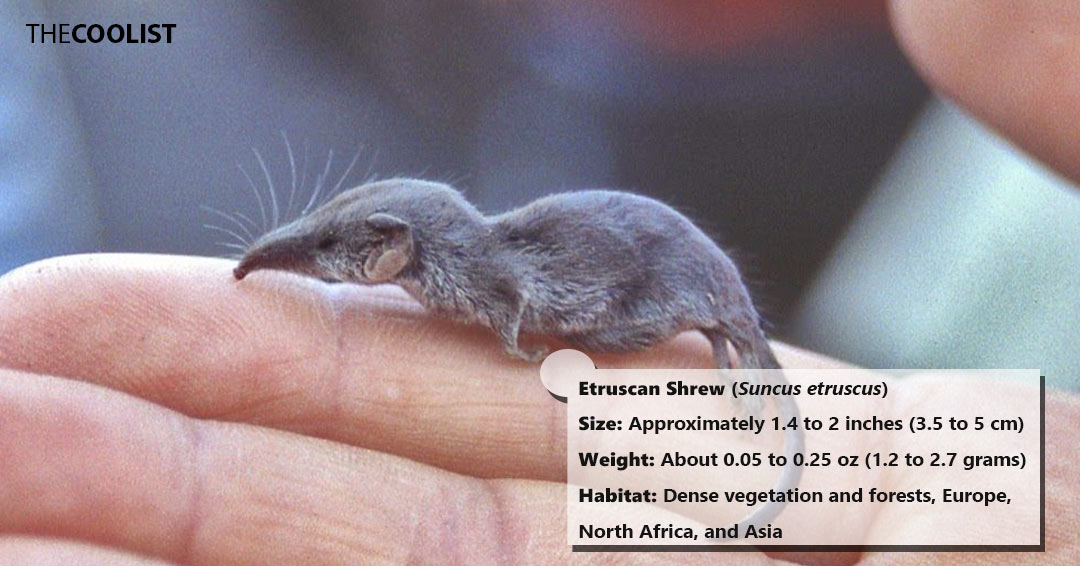
The Etruscan shrew has a broad distribution. It ranges from Europe to North Africa and Asia, residing in dense vegetation and forests. The shrew handles the cold poorly despite its thicker winter coat. However, it demonstrates a high metabolic rate and the ability to enter temporary torpor to help cope with low temperatures. Additionally, the shrew is very active due to its high metabolism. It spends most of its time hunting for food and is capable of consuming more than its body weight. The Etruscan shrew’s diet consists of various invertebrates, insects, spiders, and even young lizards.
These shrews are largely solitary, but pair up for several months to a year when they mate. Litters range from two to six offspring, who reach maturity by several weeks of age. Ecologically, Etruscan shrews are territorial and aid in pet control. They’re additionally part of the diet of birds of prey in their regions. The shrews’ broad distribution means they’re not a threatened species, but still face threats from habitat destruction and climate change. Human interaction is minimal because of their size and largely nocturnal tendencies.
5. Bee hummingbird
Bee hummingbirds (Mellisuga helenae) are the world’s smallest birds. They exhibit a body length of 2 to 2.4 inches (5 to 6 cm) and a weight of 0.056 to 0.071 ounces (1.6 to 2.0 grams). The bee hummingbird is notable not only for its size but its iridescent plumage and plump body. Males display a blue upper body, vibrant red feathers, and a green head, while females demonstrate a predominantly iridescent green body.

Bee hummingbirds are native to Cuba’s mainland and the Isla de la Juventud in the Caribbean. They reside in forests and fields. The species’ diet is primarily nectar, which is typical of hummingbirds. They gather nectar from flower plants but occasionally supplement their diets with small invertebrates. The species is capable of eating half of its body weight. Meanwhile, bee hummingbirds’ reproductive behavior centers on the creation of small, cup-shaped nests made of equally small and delicate materials such as spiderwebs. Females lay the smallest eggs in the bird world, each being no larger than a pea.
This species contributes to their ecosystem in various ways. For example, bee hummingbirds aid in pollination through their main diet of flower nectar, which helps populate flowers across forests and fields. They additionally aid in population control by feeding on small insects. Meanwhile, human interaction is both positive and negative. Bee hummingbirds are nationally admired due to their unique size and coloring. However, humans impact the species through habitat destruction and climate change, which pose significant threats to the population.
6. Madame Berthe’s mouse lemur
Madame Berthe’s mouse lemur (Microcebus berthae) is the world’s smallest primate. The lemur averages 3.6 inches (9.2 cm) and 1.1 ounces (30 grams) for its body length and weight respectively. It displays similar physical features as other lemurs, namely large eyes suited for nocturnal life, a long tail, and extended fingers to assist with climbing. It is distinct from well-known cousins like the ring-tailed lemur not only due to its size but also its blend of reddish-brown and gray fur.
View in gallery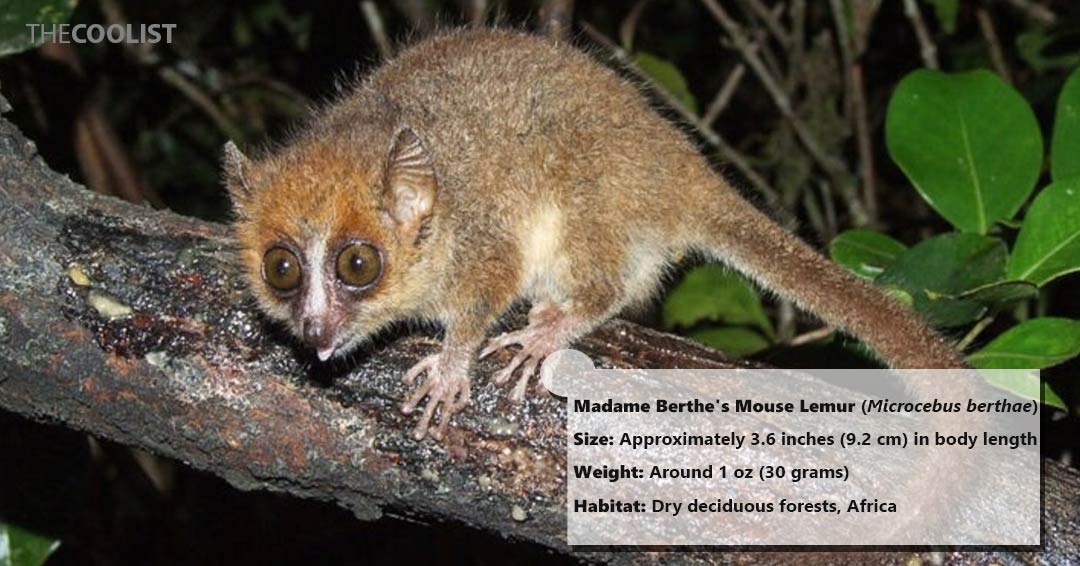
Madame Berthe’s mouse lemurs reside in western Madagascar within dry deciduous forests. They are omnivorous, which means they feed on various sources including fruit, insects, and small vertebrates. Madame Berthe’s mouse lemurs are additionally capable of torpor, which means they lower their body temperature and metabolic rate during difficult periods, such as food scarcity. Like many lemurs, they’re primarily solitary but do socialize and even sleep in troops with other individuals. They mate annually with females producing one to three offspring per year.
The ecological role of Madame Berthe’s mouse lemur is crucial for seed dispersal, insect population control, and food webs. They’re both predator and prey, feeding on insects and vertebrates whilst being part of the diets of local snakes, owls, and mongooses. Consequently, they partake in many ecological relationships and contribute to the health of their forest ecosystem. However, the species is critically endangered. Human interaction leads to habitat destruction and deforestation. The exclusive range of Madame Berthe’s mouse lemurs in Madagascar restricts their population even further, making regrowth a challenge.
7. Williams’ dwarf gecko
Williams’ dwarf gecko (Lygodactylus williamsi), otherwise known as the turquoise dwarf gecko, is one of the world’s smallest lizards. This species reaches a length of up to 4 inches with an underreported average weight. The gecko is famous due to the males’ vibrant blue and green coloration and the females’ more subtle green camouflage. Both sexes display a distinctive orange underbelly and scarcely occupy the size of a human palm.
View in gallery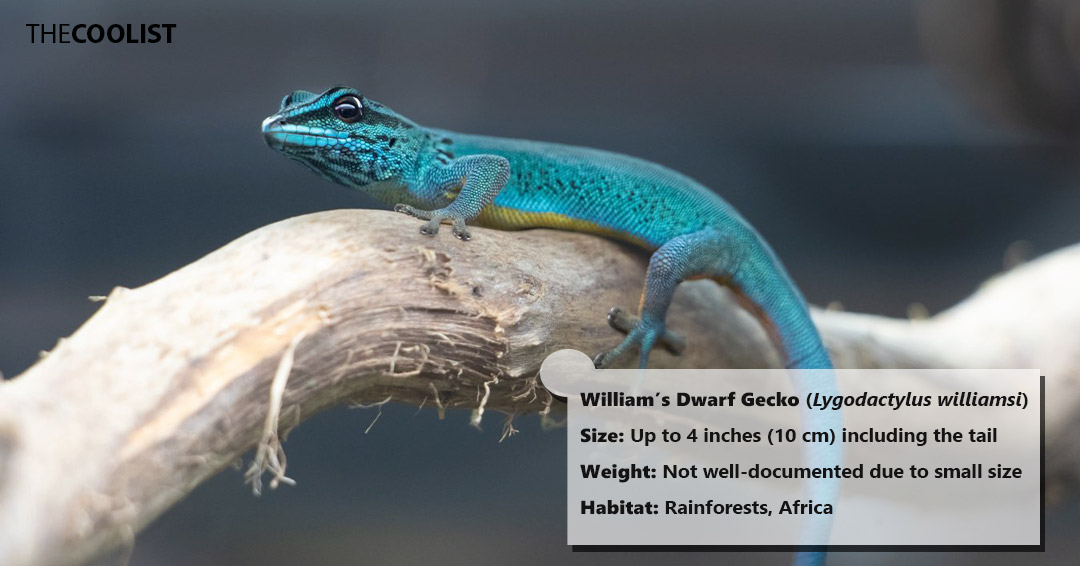
Kimboza Forest in Tanzania makes up the gecko’s primary habitat. They reside in screw pine trees native to the region, where they hunt among foliage and prey on small insects and other invertebrates. Williams’ dwarf gecko is notable for its sociability. Individuals often interact with each other, though males contest territory and become aggressive if they encounter each other. They exhibit several methods of communication, including vocalization. The geckos pair up and produce one or two small eggs. Upon hatching, the offspring are barely the span of a human fingertip.
Williams’ dwarf geckos are critically endangered according to the Convention on International Trade in Endangered Species (CITES). Human interaction is largely negative, having led to significant destruction of the geckos’ primary habitat, the screw pine trees, and exploitation through the pet trade. The geckos are sought after due to their vibrant colors but require a high level of care in captivity. Appropriate feeding, temperature, space, and UV lighting are vital for the species to thrive, which has led to premature deaths as pets. The European Union and other territories consequently protect the species. Ecologically, Williams’ dwarf gecko’s impact is under study but it likely aids in insect population and is part of the diet of local predators. Therefore, its declining population poses a threat to the balance of its native ecosystem.
8. Speckled padloper tortoise
The speckled padloper tortoise (Chersobius signatus) is the smallest documented tortoise. Males of the species are smaller than females, averaging up to 4 inches (10 cm) in length and 5.3 ounces (150 grams) in weight. They exhibit a distinct speckled shell and stand out amongst other species of tortoise, representing the opposite spectrum of size variation animals like the Aldabra giant tortoise are known for.
View in gallery
The speckled padloper tortoise’s habitat resides in western South Africa. They live in rocky areas and shrublands in the arid region. Like other tortoises, the species has a herbivore diet and feeds on small plants, namely succulents. It faces predation from birds of prey and domestic dogs and takes shelter in rocky environments to avoid them. Furthermore, speckled padloper tortoises are solitary, but they do mate during autumn and spring. Due to their size, females only lay one to two eggs which they incubate in soil. Hatchlings are similarly minute, being only around 1.2 inches in length.
This species of tortoise contributes to the seed dispersal of several plant species and serves as the natural diet of carnivorous animals in the region. Its shell is also home to various types of bacteria and fungi. Despite their ecological importance, speckled padloper tortoises are endangered. Interactions with humans are largely negative with the species facing habitat loss due to agriculture and urban expansion. Additionally, these tortoises are often the target of the pet trade, which is illegal in South Africa. While they adapt to captivity, many tend to die because of insufficient conditions.
9. Slender blind snakes
Slender blind snakes are a family of micro snakes that make up the Leptotyphlopidae classification. The aforementioned Barbados threadsnake is a part of this family, of which it is the smallest member. Other notable minuscule organisms in the family include the Western blind snake (R. humilis), found in the United States and Mexico, and the black thread snake (L. nigricans), found in South Africa. Members of this family average 4 to 5 inches (10 to 12 cm) in length and possess a nimble body that aids in their burrowing lifestyle.
View in gallery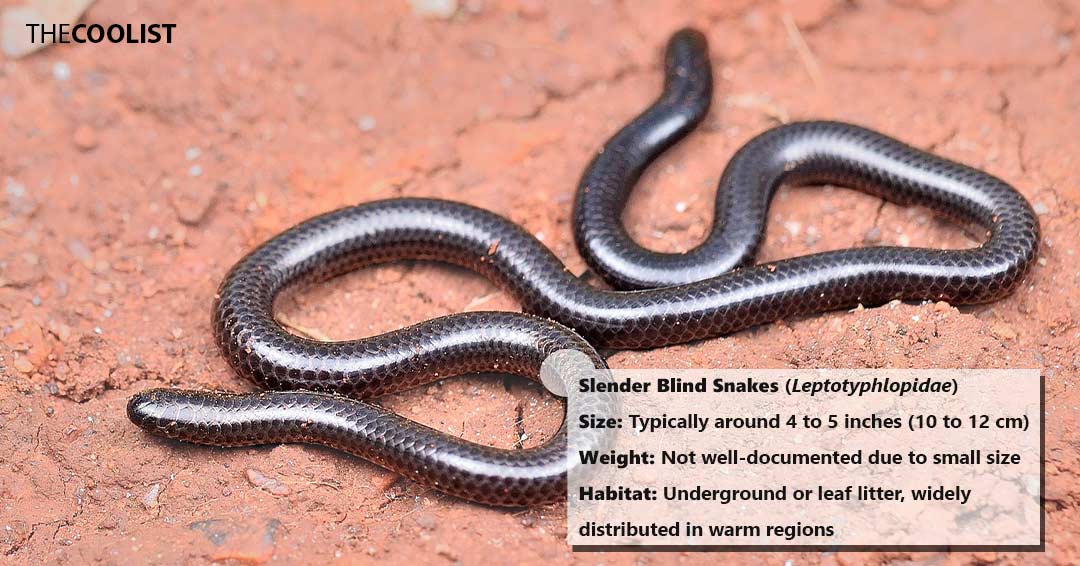
These snakes inhabit a variety of environments, from deserts to tropical forests. They tend to live underground or among leaf litter where they primarily prey on ants, termites, and their larvae. The behavior of slender blind snakes is split between their subterranean and nocturnal activities. Most are burrowers and spend much of their life beneath the soil, aided by their smooth, seamless scales and thread-like bodies. They emerge in the night to forage for food, avoiding predators and high temperatures. They lay small clutches of one or two eggs when they reproduce, though this varies. The species’ offspring is fully independent after hatching.
Ecologically, slender blind snakes contribute to the health of their habitats by controlling pest populations and aerating the soil through their burrowing activities. Human interactions are rare due to the snakes’ elusive nature and subterranean habits. While not often affected by direct human activity, their populations are threatened by habitat destruction and pollution. For instance, the Barbados threadsnake’s population is declining due to habitat loss from urban development, agriculture, and logging.
10. Barbados threadsnake
Barbados threadsnakes (Tetracheilostoma carlae) are the smallest species of snake. Adults average a length of 4.1 inches (10.4 cm) and an under-documented body weight. The species features a thread-like body as noted by its name, and dark brown coloration to suit its preferred environment, soil. It lacks many of the characteristic physical features of a larger snake, including large scales, a pronounced distinction between the head and body, and the ability to gape their mouths open—a movement called maxillary kinematics.
View in gallery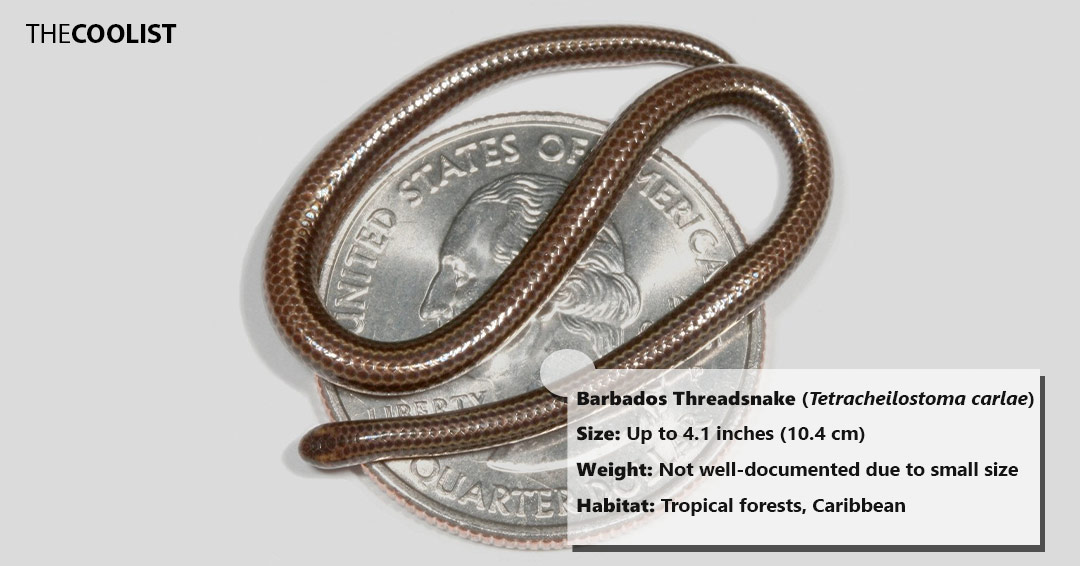
This species of thread snake originates from the tropical forests of Barbados. It’s a burrowing snake, living beneath the forest’s leaf litter and soil. The snake feeds on small invertebrates, particularly ant and termite larvae. Their diet is limited due to the small size of their mouths, which prevents them from predating on larger or wider animals as larger snakes often do. They exhibit solitary behavior with a female laying only a single egg at a time. Whereas the young of large snakes are significantly smaller than their parents, hatchlings of the Barbados threadsnake are about half the size of their mother.
Ecologically, the Barbados threadsnake helps to control the invertebrate population of ants and termites. Human interaction with this species is rare, largely due to its elusive nature and the specific environment it inhabits. However, the snake faces threats from habitat destruction. Barbados’ natural landscape is diminished which limits the species to secondary forest growth. Consequently, the snake is critically endangered.
11. Pygmy marmoset
The pygmy marmoset (genus Cebuella) refers to two different species: the western pygmy and the eastern pygmy marmoset. They’re among the smallest primates, outranked only by the previously discussed Madame Berthe’s mouse lemur in Madagascar. Pygmy marmosets average 4.6 to 6.2 inches (11.7 to 15.8 cm) in length and weigh 3.5 to 4.9 ounces (100 to 140 grams). Physical features vary between the two species but generally consist of a dense coat, a ringed tail longer than its body which aids in balance, specialized teeth that pierce tree bark, and sharp claws for tree climbing.
View in gallery
Pygmy marmoset’s distribution includes the tropical forests of the Western Amazon basin. The two species are spread between Brazil, Colombia, Ecuador, Peru, and Bolivia. Their diet is unique as they primarily consume tree gum, a substance similar to but functionally different from tree sap. The monkeys additionally eat insects, fruits, and nectar. Like many other primates, pygmy marmosets are highly social and live in small groups. Couples tend to be monogamous and stay together to produce several litters of twins, singles, or triplets.
This species of marmosets additionally demonstrates a unique series of calls and body cues, making them scientifically significant to researchers. They play an important ecological role through their part in pollination and seed dispersion, as well as in the diets of local predators like snakes. However, they face vulnerability due to declining habitats and the exotic pet trade. The legality of pet pygmy marmosets in the United States varies, but their trade is restricted in their native regions as they’re wild, undomestic creatures with a threatened population.
12. Dwarf lanternshark
Dwarf lanternsharks (Etmopterus perryi) hold the title of the world’s smallest shark species and is a member of the bioluminescent Etmopteridae family. This animal demonstrates a body length of up to 8.3 inches (21 cm) and underreported average weight. Females are characteristically larger than males, which suggests sexual dimorphism. The species is a lantern shark which means it demonstrates photophore patterns on its skin that emit light. This physical feature adds to their distinctiveness as well as their ability to camouflage from predators or attract prey.
View in gallery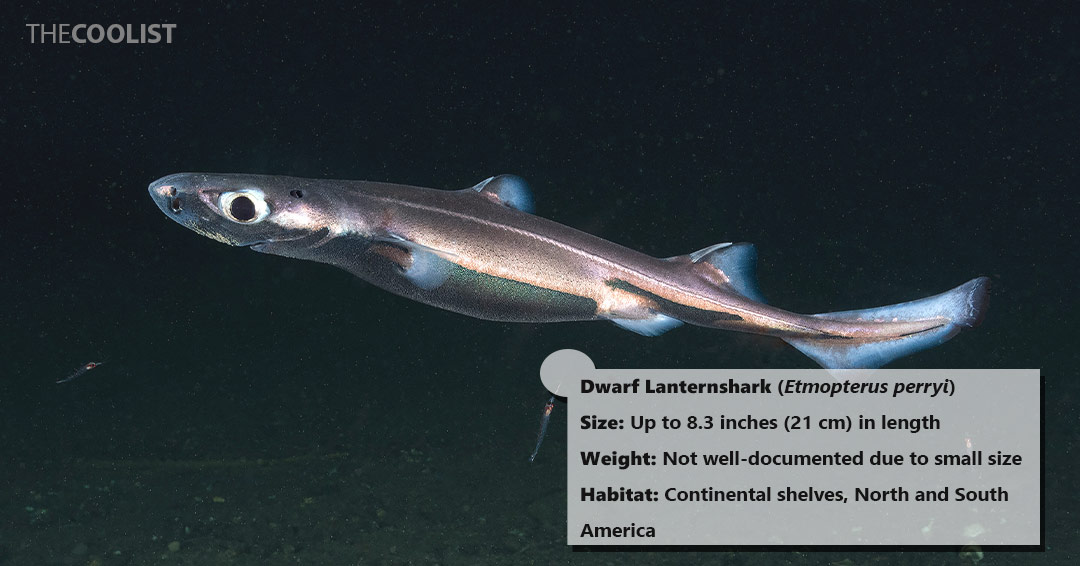
Dwarf lanternsharks are native to the Caribbean Sea and the northern Atlantic Ocean. They specifically reside near or in Colombian and Venezuelan continental waters. Similar to other lantern sharks, they live in deep waters that receive little to no sunlight. The species preys on small fish and plankton, utilizing its light-emitting capabilities to attract food. Dwarf lanternshark additionally demonstrates aplacental viviparous, which means they give birth to live young. (This is common among some species of sharks.) Females produce two to three offspring during an unspecified mating period.
Dwarf lanternshark is likely ecologically integral to its marine food web. They’re potentially both predator and prey within their local ecosystem, being a part of the diet of larger marine creatures in the deep seas. However, little is known about the species because of the depths they reside in. The International Union for Conservation of Nature does not list them as a threatened species and they are not targeted by commercial fishing, but nevertheless face threats from human activities.
13. Pygmy rabbit
Pygmy rabbits (Brachylagus idahoensis) stand out as the smallest species of rabbit. The animal’s size is approximately 9.4 to 11.6 inches (24 to 29.5 cm) in length and weighs around 14 ounces (400 grams). The rabbit’s physical features comprise a grayish-brown, rounded ears, and a lack of a prominent tail.
View in gallery
Pygmy rabbits inhabit the western United States where they take shelter and feed on sagebrush, their primary source of nutrition. They additionally feed on grasses and forbs when available. As prey animals, they are adapted to a life of vigilance and use their burrowing abilities to evade predators. These rabbits are also solitary and territorial. However, reproductive instincts lead them to build burrows within sagebrush to mate and hide their young. Pygmy rabbits produce several litters throughout the year, typically producing six kits on average.
The rabbit species plays an important role in its ecosystem, similar to other wild rabbits. For instance, it contributes to the health and regeneration of sagebrush by making up their primary food source. However, human activities such as agriculture, development, and resource extraction have led to habitat loss and fragmentation.
How do the smallest animals in the world affect the ecosystem?
The smallest animals in the world affect their ecosystems through a complex web of relationships. Ecosystems are communities of living organisms that interact with each other and their surroundings to form a largely interdependent system. The smallest animals such as parasitic Myxobolus shekel and the larger, but still minuscule Williams’ dwarf gecko are all part of ecosystems, which they affect through pollination, population control, food webs, or similar. For example, the bee hummingbird is a pollinator and helps plant reproduction by transferring pollen during its feeding. Meanwhile, species like the Etruscan Shrew help control the local insect populations whereas aquatic microorganisms like Myxobolus shekel reside within the bodies of fish, affecting their health and, indirectly, the aquatic food web. Such interactions support the balance of ecosystems, preventing any one species from becoming too dominant.
What is the smallest animal that can be kept as a pet?
The smallest animal you can keep as a pet varies on the species, legal requirements, and care requirements. Poison dart frogs are among the smallest pets you can keep outside of insects, dwarf shrimp, or fish species such as the neon tetra. Poison dart frogs range from 0.75 to 1.5 inches and are typically no longer than a US dime. They’re legal to keep as pets in most states as an appropriate diet removes their toxicity. They require a humid environment, with temperatures ranging from 70°F to 80°F (21°C to 27°C), and a terrarium to mimic their natural habitat.
Meanwhile, other micro pets such as dwarf shrimp and neon tetra are legal to keep as pets in the United States. Neon tetras measure 1.5 inches, while dwarf shrimp measure about the same or less. They require minimal space but need specific water conditions to thrive. Both species necessitate clean, well-filtered water with stable temperatures between 72°F to 78°F for neon tetras and 65°F to 80°F for dwarf shrimp.
Notable small creatures, such as the speckled padloper tortoise, pygmy marmosets, or Williams’ dwarf gecko, are often kept as pets. However, this is illegal as they’re threatened species and protected under various conservation laws. Their removal from the wild disrupts local ecosystems and endangers their populations further. Moreover, many of them struggle to adapt to captivity, which reduces their population further.
What is the smallest land animal?
The smallest land animal is the Paedophryne amauensis. It measures 0.0042 ounces with a length of 0.3 inches. It was discovered in Papua New Guinea in 2009 nesting among leaf litter. The frog feeds on insects and has no documented natural predators, though it likely faces threats from local fauna. The Paedophryne amauensis is additionally distinct from other frogs because it doesn’t have a tadpole stage, lacks webbed fingers, and hatches fully formed, minuscule young.
What is the smallest water animal?
The smallest water animal is split between Myxobolus shekel, a species of Myxozoa, and a phytoplanktonic copepod of the genus Stygotantulus. Myxobolus shekel is 0.0003 inches (8.5 µm or 0.0085 mm) in length. Myxozoa, including Myxobolus shekel, are parasitic microorganisms that defy traditional animal classification because they exhibit traits of both protozoans and multicellular animals. They were initially identified as protozoans but reclassified as part of the Cnidaria phylum. Due to this reclassification, Myxobolus shekel is the arguably smallest known animal.
However, according to a more traditional understanding of animals, the phytoplanktonic copepod Stygotantulus is the smallest water animal and the smallest arthropod. Copepods are freshwater crustaceans averaging 0.04 inches, but the Stygotantulus measures less than 0.004 inches in length. As a result, it’s one of the smallest multicellular aquatic organisms. The genus plays an ecological role similar to other copepods. It’s part of freshwater food webs and comprises the diet of several fish and invertebrates.
What is the smallest flying animal?
The smallest flying animal is an insect called Kikiki huna. The Kikiki huna features a body length of 0.0059 inches (0.15 mm) and descends from a microspecies of fairyfly wasps. The Kikiki huna’s size is only contested by the Dicopomorpha echmepterygis, which is the smallest known insect and measures 0.00547 inches (0.139 mm).
Meanwhile, the smallest known flying vertebrates are the bee hummingbird and Kitti’s hog-nosed bat. The bee hummingbird is the smallest flying bird, while Kitti’s hog-nosed bat is the smallest flying mammal. The latter beats out the hummingbird through its body length, measuring 1.1 to 1.3 inches whereas the hummingbird measures 2.0 to 2.4 inches. Both weigh under one ounce.
How do small animals affect other animals?
Small animals affect other animals in multifaceted ways due to the ecological role they play. Many serve as prey. For example, the pygmy rabbit (the smallest species of leporid) is part of the diet of various carnivorous species, including coyotes, bobcats, and weasels local to its region. Consequently, they’re integral to food webs. Meanwhile, other small animals contribute to insect population control. For example, the Etruscan shrew and Paedophryne amauensis consume various insects, thereby regulating pest populations and preventing overfeeding of crops or native plants. This balance is essential for the health of ecosystems where plants, insects, and larger predatory animals thrive according to these interactions.
What are the heaviest animals in the world?
Below are three examples of the heaviest animals in the world.
- Blue whale: Blue whales are the heaviest animals to ever live. They weigh up to 200 tons (180,000 kg) and birth calves at 2.5 tons (2,270 kilograms). They reside in deep waters worldwide and migrate from tropical breeding to colder feeding areas. They eat primarily krill, consuming up to 4 tons daily, and lead largely solitary lives.
- Whale shark: Whale sharks are one of the heaviest living animals and the largest living fish. They average 20.5 tons (18,700 kilograms) and live in warmer waters. Despite being sharks, they do not prey on large aquatic creatures. Instead, they primarily feed on plankton through filter-feeding and exhibit gentle, curious behavior towards humans.
- Elephant: Elephants are the heaviest land mammals. The largest of its kind is the African bush elephant which weighs 10.4 tons (roughly 9,500 kg). Others of the species include the African forest elephant (6 tons) and the Asian elephant (4.4 tons). They demonstrate several physical features that highlight their weight, such as large ears and muscular trunks. They typically stand at 8 to 13 feet and primarily live in matriarchal societies.
What are the tallest animals in the world?
Below are three examples of the tallest animals in the world.
- Giraffe: The giraffe is the tallest living terrestrial animal, reaching heights of up to 18 feet (5.5 meters). They are additionally among the heaviest living animals on account of their size—weighing between 1,800 and 2,600 pounds. Their long necks and tongues allow them to feed on leaves, fruits, and flowers of high trees. They reside in sub-Saharan Africa where they face natural threats from lions, leopards, and hyenas.
- Elephant: Elephants are amongst the heaviest and thus one of the tallest. The male African bush elephant is the tallest of the species and reaches up to 13 feet, in addition to their weight. This height aids in reaching high branches and leaves for feeding, allowing them to access a wider variety of food sources. Their weight and height serve as a deterrent to predators. Consequently, the successful hunt of an adult African bush elephant by a lion or another apex predator is rare.
- Ostrich: The ostrich is the world’s largest living bird and consequently its tallest. They reach up to 9 feet (2.7 meters) tall and weigh as much as 320 pounds (145 kilograms). Similar to the giraffe and elephant, they reside in African savannas and deserts. Other notable features include a high running speed, sustaining 30 to 35 mph and reaching 45 mph at top speeds.

